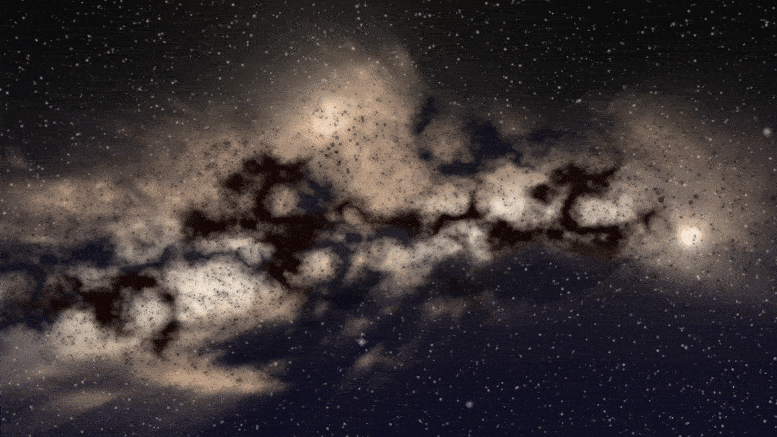
Astrophysics’ concept of dark matter, constituting approximately 85% of the universe’s matter, remains elusive as it lacks luminosity and cannot be directly observed. Its true nature remains poorly understood.
UC Riverside-led study found self-interacting dark matter theory explains why two galaxies have less dark matter than others.
A new theory about the nature of dark matter helps explain why a pair of galaxies about 65 million light-years from Earth contains very little of the mysterious matter, according to a study led by a physicist at the University of California, Riverside.
Dark matter is nonluminous and cannot be seen directly. Thought to make up 85% of matter in the universe, its nature is not well understood. Unlike normal matter, it does not absorb, reflect, or emit light, making it difficult to detect.
The prevailing dark matter theory, known as cold dark matter, or CDM, assumes dark matter particles are collisionless, aside from gravity. A newer second theory, called self-interacting dark matter, or SIDM, proposes dark matter particles self-interact through a new dark force. Both theories explain how the overall structure of the universe emerges, but they predict different dark matter distributions in the inner regions of a galaxy. SIDM suggests dark matter particles strongly collide with one another in a galaxy’s inner halo, close to its center.
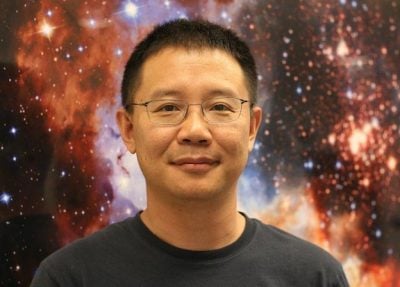
Hai-Bo Yu is a theoretical physicist with expertise in the particle properties of dark matter. Credit: Samantha Tieu
Typically, a visible galaxy is hosted by an invisible dark matter halo — a concentrated clump of material, shaped like a ball, that surrounds the galaxy and is held together by gravitational forces. Recent observations of two ultra-diffuse galaxies, NGC 1052-DF2 and NGC 1052-DF4, show, however, that this pair of galaxies contain very little, if any, dark matter, challenging physicists’ understanding of galaxy formation. Astrophysical observations suggest NGC 1052-DF2 and NGC 1052-DF4 are likely satellite galaxies of NGC1052.
“It is commonly thought that dark matter dominates the overall mass in a galaxy,” said Hai-Bo Yu, an associate professor of physics and astronomy at UCR, who led the study. “Observations of NGC 1052-DF2 and -DF4 show, however, that the ratio of their dark matter to their stellar masses is about 1, which is 300 times lower than expected. To resolve the discrepancy, we considered that the DF2 and DF4 halos may be losing the majority of their mass through tidal interactions with the massive NGC 1052 galaxy.”
Using sophisticated simulations, the UCR-led team reproduced the properties of NGC 1052-DF2 and NGC 1052-DF4 through tidal stripping — the stripping away of material by galactic tidal forces — by NGC1052. Because the satellite galaxies cannot hold the stripped mass with their own gravitational forces, it effectively gets added to NGC 1052’s mass.
The researchers considered both CDM and SIDM scenarios. Their results, published in Physical Review Letters, indicate SIDM forms dark-matter-deficient galaxies like NGC 1052-DF2 and -DF4 far more favorably than CDM, as the tidal mass loss of the inner halo is more significant and the stellar distribution is more diffuse in SIDM.
The research paper has been selected as an “editors’ suggestion” by the journal, an honor that only a select few papers receive each week to promote reading across fields.
Yu explained tidal mass loss could occur in both CDM and SIDM halos. In CDM, the inner halo structure is “stiff” and resilient to tidal stripping, which makes it difficult for a typical CDM halo to lose sufficient inner mass in the tidal field to accommodate observations of NGC 1052-DF2 and -DF4. In contrast, in SIDM, dark matter self-interactions could push dark matter particles from the inner to the outer regions, making the inner halo “fluffier” and enhancing the tidal mass loss accordingly. Further, the stellar distribution becomes more diffuse.
“A typical CDM halo remains too massive in the inner regions even after tidal evolution,” Yu said.
Next, the team will perform a more comprehensive study of the NGC 1052 system and explore newly discovered galaxies with novel properties in an effort to better understand the nature of dark matter.
Reference: “Self-Interacting Dark Matter and the Origin of Ultradiffuse Galaxies NGC1052-DF2 and -DF4” by Daneng Yang, Hai-Bo Yu and Haipeng An, 9 September 2020, Physical Review Letters.
DOI: 10.1103/PhysRevLett.125.111105
Yu was joined in the study by Daneng Yang and Haipeng An of Tsinghua University in Beijing, China. Yu was supported by grants from the U.S. Department of Energy and the U.S. National Science Foundation.

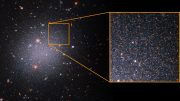
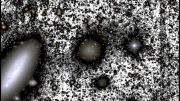

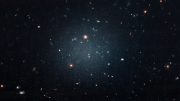
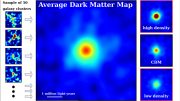
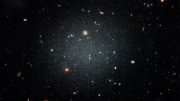
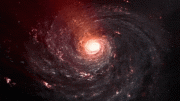
Theory inversion principle – the more theories required to explain something, the less likely that any of the theories are valid.
A good thing then that LCDM explains the universe on all scales at all times.
I’ve got it! Trump’s brain is dark matter. You know that it must be there, but there is no evidence of it anywhere!
Well after Eddie’s comment, I’ll Venture that without Dark Matter DF2 and DF4 Galaxies may be inhabited by angels, and never suffered Original Sin.
LOL. Yes, I think y’all have finally cracked it. Had to happen sooner or later.
I’ve been fascinated by Dark Matter for many years. What do you want to know. As Frankie Valli would say so close but yet so far. It is basically also Relative. I am all the answers Incorporated show me the Doe. DarkMatter Something That Will Frighten You.
Perfect! Many things about the theory that don’t make sense to me, but, have posted this before and would really like to know:
According to NASA’s website, “It turns out that roughly 68% of the universe is dark energy. Dark matter makes up about 27%. The rest – everything on Earth, everything ever observed with all of our instruments, all normal matter – adds up to less than 5% of the universe.”
If dark energy and matter make up over 95% of the universe, why is there zero evidence for it not making up over 95% of our own solar system? Are we completely unique in the universe? Statistically, what are the odds of that? According to the theory, less than 5% of our own solar system is what we’re observing in our solar system. Yet, why don’t solar system researchers ever invoke dark matter or dark energy for explaining the dynamics and what they observe in our solar system? Or when they run into something they can’t explain, why do they never seem to ever even consider trying to explain it with dark matter or energy? Doesn’t seem to even be on their radar.
“If dark energy and matter make up over 95% of the universe, why is there zero evidence for it not making up over 95% of our own solar system?”
Because the average density of dark matter – or even the dark matter halo density – gives the volume of the solar system an asteroid worth of dark matter. That is 10^-5 times the amount that we can observe with orbital mechanics tracking. This is graduate problems in astronomy, and not something that hasn’t been asked and answered many times over – google it: “Ask Ethan: If Dark Matter Is Everywhere, Why Haven’t We Detected It In Our Solar System? It’s the first, most naive question you might think to ask. … But until our measurements become more and more precise, there simply isn’t enough of a gravitational effect to result in anything detectable. For the meantime, we have to look to the Universe beyond, not our own Solar System, to see dark matter’s effects on spacetime.” [ https://medium.com/starts-with-a-bang/ask-ethan-if-dark-matter-is-everywhere-why-havent-we-detected-it-in-our-solar-system-67ca11f94b1f ].
Give it a rest, dark matter has been observed on all structural scales from cosmic filaments (where gas and galaxies cluster) over galaxy clusters to dwarf galaxies. We have also seen in collections of it that it clumps down to very small scales [ https://www.nasa.gov/feature/goddard/2020/hubble-detects-smallest-known-dark-matter-clumps/ ]. “All galaxies, according to this theory, form and are embedded within clouds of dark matter. Dark matter itself consists of slow-moving, or “cold,” particles that come together to form structures ranging from hundreds of thousands of times the mass of the Milky Way galaxy to clumps no more massive than the heft of a commercial airplane.”
“Or when they run into something they can’t explain, why do they never seem to ever even consider trying to [not] explain it with dark matter or energy?”
Because LCDM works and there isn’t any useful alternatives.
No, not observed, deduced, very different. And LCDM has it’s own set of problems, ie:
in recent years there have been at least four LCDM model major failures. It’s totally failed to correctly predict an excess abundance of Population III stars at high redshifts, which was a key prediction of stellar evolution over time. It failed to correctly predict the size and maturity of distant galaxies, failing another key prediction related to galaxy evolution over time. It failed to correctly predict supermassive quasars too, failing another important test of a black hole evolution over time. It’s still in five sigma self conflict with the Hubble constant as predicted by the Planck data too, in spite of a massive fudge factor addition of around 70 percent of the model just two decades ago. There’s literally nothing that it correctly predicts at high redshift.
https://scitechdaily.com/discovery-of-massive-galaxy-just-1-5-billion-years-after-the-big-bang-has-astronomers-questioning-formation-models/
https://www.ibtimes.com/massive-quasars-dawn-time-defy-theoretical-models-black-hole-formation-2537928
https://skyandtelescope.org/astronomy-news/tension-continues-hubble-constant/
This is in addition to the fact that the LCDM model grossly violates the conservation of energy laws twice within the very same model.
Another oops for black hole theory: https://www.sciencedaily.com/releases/2020/06/200625140723.htm “Data show the supermassive black hole powering Poniua’ena is surprisingly massive, challenging current theories of how supermassive black holes formed and grew in the young universe.”
“How can the universe produce such a massive black hole so early in its history?” said Xiaohui Fan, Regents’ professor and associate department head of the Department of Astronomy at the University of Arizona. “This discovery presents the biggest challenge yet for the theory of black hole formation and growth in the early universe.”
Also, this paper is from 2007, but makes excellent points about the amount of damage the fanatical adherence to the beliefs in dark matter and dark energy are causing to the field of cosmology and funding other investigation paths: https://www.scribd.com/document/254560977/LCDM-Cosmology-How-Much-Suppression-of-Credible-Evidence
And this is very typical. Big buzz that Sagittarius A would gobble up the G2 gas cloud in 2014. But what happened when it got close enough where that should have happened? Nothing. Hmmm. Big huge supermassive black hole vs wispy gas cloud, and no effect. Another failed prediction. But, instead of that causing them to question whether the black hole existed at all, no, well, it MUST be the cloud, so yeah, G2 must be a binary star system, which black holes don’t like apparently.
Another surprise: https://www.space.com/21638-giant-black-hole-dust-surprise.html
And just look up black holes and surprise, or shock, etc, and article after article.
And it’s amazing to me that even though they have no idea what dark energy or matter are, and they’ve never directly detected it, and there certainly doesn’t seem to be any locally, it’s supposed to make up most of the universe.
But, try to get funding if you have competing theories. Very difficult, though there are those that do have other contentions, just an example:
https://theconversation.com/study-finds-dark-matter-and-dark-energy-may-not-exist-heres-what-to-make-of-it-88181
“If dark energy and matter make up over 95% of the universe, why is there zero evidence for it not making up over 95% of our own solar system?”
Because the average density of dark matter – or even the dark matter halo density – gives the volume of the solar system an asteroid worth of dark matter. That is 10^-5 times the amount that we can observe with orbital mechanics tracking. This is graduate problems in astronomy, and not something that hasn’t been asked and answered many times over – google it: “Ask Ethan: If Dark Matter Is Everywhere, Why Haven’t We Detected It In Our Solar System? It’s the first, most naive question you might think to ask. … But until our measurements become more and more precise, there simply isn’t enough of a gravitational effect to result in anything detectable. For the meantime, we have to look to the Universe beyond, not our own Solar System, to see dark matter’s effects on spacetime.” [ https://medium.com/starts-with-a-bang/ask-ethan-if-dark-matter-is-everywhere-why-havent-we-detected-it-in-our-solar-system-67ca11f94b1f ].
Give it a rest, dark matter has been observed on all structural scales from cosmic filaments (where gas and galaxies cluster) over galaxy clusters to dwarf galaxies. We have also seen in collections of it that it clumps down to very small scales [ https://www.nasa.gov/feature/goddard/2020/hubble-detects-smallest-known-dark-matter-clumps/ ]. “All galaxies, according to this theory, form and are embedded within clouds of dark matter. Dark matter itself consists of slow-moving, or “cold,” particles that come together to form structures ranging from hundreds of thousands of times the mass of the Milky Way galaxy to clumps no more massive than the heft of a commercial airplane.”
“Or when they run into something they can’t explain, why do they never seem to ever even consider trying to explain it with dark matter or energy?”
Because LCDM works and there isn’t any useful alternatives.
““Or when they run into something they can’t explain, why do they never seem to ever even consider trying to explain it with dark matter or energy?” = “Or when they run into something they can’t explain, why do they never seem to ever even consider [not]* trying to explain it with dark matter or energy?”
* I assume the intention was.
No, not observed, deduced, very different. And LCDM has it’s own set of problems, ie:
in recent years there have been at least four LCDM model major failures. It’s totally failed to correctly predict an excess abundance of Population III stars at high redshifts, which was a key prediction of stellar evolution over time. It failed to correctly predict the size and maturity of distant galaxies, failing another key prediction related to galaxy evolution over time. It failed to correctly predict supermassive quasars too, failing another important test of a black hole evolution over time. It’s still in five sigma self conflict with the Hubble constant as predicted by the Planck data too, in spite of a massive fudge factor addition of around 70 percent of the model just two decades ago. There’s literally nothing that it correctly predicts at high redshift.
https://scitechdaily.com/discovery-of-massive-galaxy-just-1-5-billion-years-after-the-big-bang-has-astronomers-questioning-formation-models/
https://www.ibtimes.com/massive-quasars-dawn-time-defy-theoretical-models-black-hole-formation-2537928
https://skyandtelescope.org/astronomy-news/tension-continues-hubble-constant/
This is in addition to the fact that the LCDM model grossly violates the conservation of energy laws twice within the very same model.
Another oops for black hole theory: https://www.sciencedaily.com/releases/2020/06/200625140723.htm “Data show the supermassive black hole powering Poniua’ena is surprisingly massive, challenging current theories of how supermassive black holes formed and grew in the young universe.”
“How can the universe produce such a massive black hole so early in its history?” said Xiaohui Fan, Regents’ professor and associate department head of the Department of Astronomy at the University of Arizona. “This discovery presents the biggest challenge yet for the theory of black hole formation and growth in the early universe.”
Also, this paper is from 2007, but makes excellent points about the amount of damage the fanatical adherence to the beliefs in dark matter and dark energy are causing to the field of cosmology and funding other investigation paths: https://www.scribd.com/document/254560977/LCDM-Cosmology-How-Much-Suppression-of-Credible-Evidence
And this is very typical. Big buzz that Sagittarius A would gobble up the G2 gas cloud in 2014. But what happened when it got close enough where that should have happened? Nothing. Hmmm. Big huge supermassive black hole vs wispy gas cloud, and no effect. Another failed prediction. But, instead of that causing them to question whether the black hole existed at all, no, well, it MUST be the cloud, so yeah, G2 must be a binary star system, which black holes don’t like apparently.
Another surprise: https://www.space.com/21638-giant-black-hole-dust-surprise.html
And just look up black holes and surprise, or shock, etc, and article after article.
And it’s amazing to me that even though they have no idea what dark energy or matter are, and they’ve never directly detected it, and there certainly doesn’t seem to be any locally, it’s supposed to make up most of the universe.
But, try to get funding if you have competing theories. Very difficult, though there are those that do have other contentions, just an example:
https://theconversation.com/study-finds-dark-matter-and-dark-energy-may-not-exist-heres-what-to-make-of-it-88181
Reading the paper cosmological CDM does a good job on those two galaxies without the extra knobs to make better fits of more complex models. The paper lacks testing the resulting model on other galaxies, so we don’t know if it is a valid model.
But those ultra diffuse galaxies are poorly understood, especially as regards dark matter content [ https://en.wikipedia.org/wiki/Ultra_diffuse_galaxy ]. “… this class of galaxies includes both extremes of dark matter content: Some UDGs consist almost entirely of dark matter (such a galaxy may have the same size and mass as the Milky Way but a visible star count of only 1%),[4] while other UDGs are almost entirely free of dark matter.[5]”
… So! What is that dark matter thing, after all?
Good question!
If it only interacts gravitationally it could be particles from a scalar field like the Higgs field, only a singlet instead of the complex SU2 Higgs doublet that couples to standard matter [ https://en.wikipedia.org/wiki/Mathematical_formulation_of_the_Standard_Model ]. So more like what the current inflation field looks like, only stable.
It would be a nice symmetry if a scalar field is associated with the observed energy scales (except for gravity, which needs a tensor field) – inflation, dark matter, Higgs + “light matter” going from high to low energies.
But it could be much more complex than that.
With “it could be particles from a scalar field like the Higgs field” I mean that they, like Higgs, lend themselves mass as the temperature of the hot big bang universe lowered during expansion. (The inflation field was not stable, so such particles though massive were unstable too.)
Is it possible the so called dark energy is actually all about how time and gravity work over vast interstellar distances? In my experience the math can be correct for normal conditions, but at extreme conditions math models can grossly wrong because of seemingly benign assumptions. It is pretty well accepted that light bends around massive galaxies. So since space-time bends, is it possible that space-time can bend in ways not yet investigated. Imagine something like eddies and currents in the fabric of space=time. Perhaps caused by cumulative undetectable micro frame dragging of gravitational waves across extreme periods of time and distance.
There is no dark matter.
The newton gravity formula is just true for Immobile matter
But this formula is false for moving matter.
For Description of the theory of motion gravity:
https://motiongravity.blogsky.com